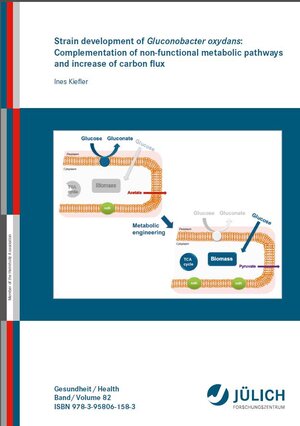
×
![Buchcover ISBN 9783958061583]()
Strain development of Gluconobacter oxydans: Complementation of non-functional metabolic pathways and increase of carbon flux
von Ines KieflerThe acetic acid bacterium Gluconobacter oxydans possesses outstanding metabolic
characteristics that are favorable for biotechnological applications in oxidative whole-cell
biotransformations. The key feature is the rapid and incomplete regio- and stereoselective
oxidation of sugars, sugar alcohols, and other carbon sources in the periplasm by a versatile
set of membrane-bound dehydrogenases. Beside the beneficial attributes, the unusual
metabolism of G. oxydans also poses a problem, which is the low cell yield resulting in high
costs for biomass production. This study aimed at an increase of the cell yield of G. oxydans
on glucose in order to improve its application potential. For this purpose, prevention of
incomplete glucose oxidation to gluconate and ketogluconates and complementation of the
incomplete tricarboxylic acid (TCA) cycle were selected as promising targets and
implemented by construction and characterization of several integration/deletion mutants:
The succinate dehydrogenase from Acetobacter pasteurianus was introduced into
G. oxydans, which naturally lacks this TCA cycle enzyme in addition to succinyl-CoA
synthetase. Plasmid-based expression of the structural genes sdhCDAB together with the
sdhE gene encoding a flavinylation factor led to a strain with high succinate dehydrogenase
activity, showing functional synthesis of this complex membrane protein containing FAD,
three iron-sulfur clusters and heme as prosthetic groups. Genomic integration of the
sdhCDABE genes with simultaneous deletion of the gdhS gene for the cytosolic glucose
dehydrogenase led to strain IK001 with considerable succinate dehydrogenase activity.
To improve the NADH oxidation capacity that might be required to handle an increased
NADH formation rate resulting from an increased cytoplasmic glucose catabolism, a second
NADH dehydrogenase gene ndh from G. oxydans strain DSM3504 was genomically
introduced into strain IK001 with simultaneous deletion of the pdc gene encoding pyruvate
decarboxylase. The resulting strain IK002.1 also showed an increased cell yield of 12 %
compared to the reference strain and secreted pyruvate instead of acetate.
In order to complete the TCA cycle of strain IK002.1 and prevent periplasmic glucose
oxidation to gluconate, the succinyl-CoA synthetase genes sucCD of Gluconacetobacter
diazotrophicus were genomically integrated with simultaneous deletion of the gdhM gene
encoding the membrane-bound glucose dehydrogenase. The resulting strain IK003.1 did not
secrete gluconate or 2-ketogluconate anymore, but formed twice as much carbon dioxide as
the reference strain, either via the cyclic pentose phosphate cycle or via the TCA cycle. The
initial glucose consumption rate was much slower and growth was delayed, but the cell yield
was increased by 60 %. Therefore, G. oxydans IK003.1 represents a promising strain for
industry due to its increased cell yield and a basis for further strain development.
characteristics that are favorable for biotechnological applications in oxidative whole-cell
biotransformations. The key feature is the rapid and incomplete regio- and stereoselective
oxidation of sugars, sugar alcohols, and other carbon sources in the periplasm by a versatile
set of membrane-bound dehydrogenases. Beside the beneficial attributes, the unusual
metabolism of G. oxydans also poses a problem, which is the low cell yield resulting in high
costs for biomass production. This study aimed at an increase of the cell yield of G. oxydans
on glucose in order to improve its application potential. For this purpose, prevention of
incomplete glucose oxidation to gluconate and ketogluconates and complementation of the
incomplete tricarboxylic acid (TCA) cycle were selected as promising targets and
implemented by construction and characterization of several integration/deletion mutants:
The succinate dehydrogenase from Acetobacter pasteurianus was introduced into
G. oxydans, which naturally lacks this TCA cycle enzyme in addition to succinyl-CoA
synthetase. Plasmid-based expression of the structural genes sdhCDAB together with the
sdhE gene encoding a flavinylation factor led to a strain with high succinate dehydrogenase
activity, showing functional synthesis of this complex membrane protein containing FAD,
three iron-sulfur clusters and heme as prosthetic groups. Genomic integration of the
sdhCDABE genes with simultaneous deletion of the gdhS gene for the cytosolic glucose
dehydrogenase led to strain IK001 with considerable succinate dehydrogenase activity.
To improve the NADH oxidation capacity that might be required to handle an increased
NADH formation rate resulting from an increased cytoplasmic glucose catabolism, a second
NADH dehydrogenase gene ndh from G. oxydans strain DSM3504 was genomically
introduced into strain IK001 with simultaneous deletion of the pdc gene encoding pyruvate
decarboxylase. The resulting strain IK002.1 also showed an increased cell yield of 12 %
compared to the reference strain and secreted pyruvate instead of acetate.
In order to complete the TCA cycle of strain IK002.1 and prevent periplasmic glucose
oxidation to gluconate, the succinyl-CoA synthetase genes sucCD of Gluconacetobacter
diazotrophicus were genomically integrated with simultaneous deletion of the gdhM gene
encoding the membrane-bound glucose dehydrogenase. The resulting strain IK003.1 did not
secrete gluconate or 2-ketogluconate anymore, but formed twice as much carbon dioxide as
the reference strain, either via the cyclic pentose phosphate cycle or via the TCA cycle. The
initial glucose consumption rate was much slower and growth was delayed, but the cell yield
was increased by 60 %. Therefore, G. oxydans IK003.1 represents a promising strain for
industry due to its increased cell yield and a basis for further strain development.


